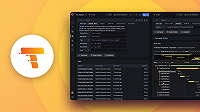Search with Google Cloud Run
This document walks you through setting up a Google Cloud Run for serverless backend search. For more guidance on configuration options for full backend search check here.
Build the docker image:
cd ./cmd/tempo-serverless && make build-docker-gcrThis will create the Docker container image to be deployed to Google Cloud Run. The docker image will be named:
tempo-serverless:latestandtempo-serverless:<branch>-<commit hash>. Here is an example of that name:$ docker images | grep tempo-serverless tempo-serverless cloud-run-3be4efa 146c9d9fa63c 58 seconds ago 47.9MB tempo-serverless latest 146c9d9fa63c 58 seconds ago 47.9MBPush the image to a Google Container Registry repo.
Provision the Google Cloud Run service. This example uses Terraform. Configuration values should be adjusted to meet the needs of your installation.
locals { // this can be increased if you would like to use multiple functions count = 1 } resource "google_cloud_run_service" "run" { count = local.count name = "<service name>" location = "<appropriate region>" metadata { annotations = { "run.googleapis.com/ingress" = "internal", # this annotation can be used to limit connectivity to the service } } template { metadata { annotations = { "autoscaling.knative.dev/minScale" = "1", "autoscaling.knative.dev/maxScale" = "1000", "autoscaling.knative.dev/panic-threshold-percentage" = "110.0", # default 200.0. how aggressively to go into panic mode and start scaling heavily "autoscaling.knative.dev/window" = "10s", # default 60s. window over which to average metrics to make scaling decisions } } spec { container_concurrency = 4 containers { image = "<container image created above>" resources { limits = { cpu = "2" memory = "1Gi" } } env { name = "TEMPO_GCS_BUCKET_NAME" value = "<gcs bucket where tempo data is stored>" } env { name = "TEMPO_BACKEND" value = "gcs" } env { name = "TEMPO_GCS_HEDGE_REQUESTS_AT" value = "400ms" } env { name = "TEMPO_GCS_HEDGE_REQUESTS_UP_TO" value = "2" } env { name = "GOGC" value = "400" } } } } traffic { percent = 100 latest_revision = true } }Add the newly-created cloud run service as external endpoints in your querier configuration. The endpoint can be retrieved from the Details tab in Google Cloud Run:
querier: search: external_endpoints: - <trigger url from console>


